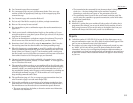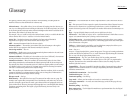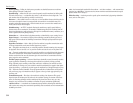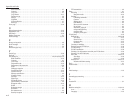
Just in case …
MH
— Modified Huffman, the standard
ITU
-
T
Group 3 data compression method. A one-dimen-
sional coding scheme that compresses data in a horizontal direction only. A feature of all our
fax machines,
MH
assures transmissions faster than one page per minute when communicat-
ing with other Group 3 units, regardless of manufacturer. See also
MR
,
MMR
.
Military format — See 24-hour format.
Modem — Modulator-demodulator. A device that converts digital data, like information from
a fax machine, into an analog signal for transmission over ordinary telephone lines. A modem
is included in a fax machine and allows it to be connected directly to a
PSTN
telephone line.
MR
— Modified Read, an
ITU
-
T
Group 3 standard data compression method. A two-dimen-
sional coding scheme that compresses data in both horizontal and vertical directions and
allows for faster transmission when communicating with other Group 3 units, regardless of
manufacturer.
MMR
— Modified Modified Read, an
ITU
-
T
Group 3 standard data compression method. A two-
dimensional coding scheme that compresses data in both horizontal and vertical directions
and allows for faster transmission when communicating with other Group 3 units, regardless
of manufacturer.
Monitor — A speaker in most our fax machines which allows the user to hear the dialing
process. This is not a speakerphone, because it has no microphone for speaking to the person
being called.
MSE
,
SMSE
— The proprietary data compression methods.
Normal resolution — Shown as “norm”; 203
H
× 98
V
lpi. The default resolution mode for all
our fax machines.
Original document size — The largest (or smallest) document that can be fed safely
through a fax machine.
Override — To change existing settings.
Paper sizes — All are width × length:
Letter-sized = 8.5″×11.0″ (216 × 279 mm) Legal-sized = 8.5″×14.0″ (216 × 356 mm)
A5 = 5.8″× 8.3″ (148 × 210 mm) B5 = 7.2″×10.1″ (182 × 257 mm)
A4 = 8.3″×11.7″ (210 × 297 mm) B4 = 10.1″×14.3″ (257 × 364 mm)
A3 = 11.7″×16.5″ (297 × 420 mm)
Passcode — A four-digit code-number. On your fax machine, the protection passcode lets the
user limit access to fax operations, as well as certain settings and even documents readied for
polling (in the case of polling, only calling machines whose users enter the proper passcode
will be able to poll the document.)
PBX
(or
PABX
) — Private branch exchange; privately-owned telephone equipment serving a
particular building, business or area. Many
PBX
systems use digital transmission lines which,
unlike more common
PSTN
lines, are not compatible with fax machine use. The user should
not connect a fax unit to a
PBX
without first checking with the system manufacturer or ser-
vice representative.
PCL — Page Control Language. An industry standard for printer control. Some our fax
machines include or offer PCL-compatible printing for Windows-based personal computers.
Platen — A traditional copier-style top to a fax machine or digital copier. Some our fax
machines and multifunctional products include a platen top, allowing you to fax from books
and other awkward sources.
Polling — Automatic transmission to a calling remote fax, or reception of a document from a
remote fax set for this operation. Polling is convenient whenever a central unit must receive
information from one or several remote faxes. The caller bears all telephone charges and pre-
vents several remote units from calling at the same time. See also Secure polling.
Private line — (Or leased line.) A service offered by many telephone systems; provides an
exclusive phone circuit between two geographic points. Your fax does not require a private
line. See also
PSTN
.
Proprietary — Non-standard. In fax, refers to a fax feature which works only in communi-
cations between fax machines that are the same brand.
PSTN
— Public switched telephone network; the most common type of telephone lines and
service in use, in contrast to private or leased lines. Your fax provides fast, reliable data
transmission over a
PSTN
line, and does not need a special or dedicated telephone line. See
also Private line.
Receiver
ID
— See Station
ID
.
Redialing — The dialing again, either manually or automatically controlled, of the most
recently dialed fax or phone number. Automatic redialing follows an unsuccessful dialing
attempt and can be done manually or automatically.
Relay broadcasting — Lets some Konica fax machines store a document in internal mem-
ory, transmit the document to the memory of a remote “hub” fax and then instruct that unit
to relay (re-transmit) the document to each fax in a call group in the “hub” unit. This feature
speeds extremely high-volume fax communication and allows a single command to initiate
document transmission to hundreds of preprogrammed fax locations. It also saves phone
charges for the originating machine. Your machine can initiate a relay broadcast.
Remote fax machine — The machine on the other “end” of a fax communication.
REN
— See Ringer equivalence number.
Resolution — The resolution of documents transmitted or copied by fax machines is mea-
sured by the number of horizontal (
H
) and vertical (
V
) lines per inch (lpi) the unit can print.
Our unit may offer one or more of these resolution levels:
Normal 203
H
× 98
V
lpi
Fine 203
H
× 196
V
lpi
Superfine 203
H
× 392
V
lpi
Some our units also offer grayscale transmission (see also Grayscale) for accurate reproduc-
tion of photographs and other shaded originals.
Ringer equivalence number — Also called
REN
. A number assigned to telecommunications
equipment used in the United States; designed to prevent overloading on a telephone circuit.
See also Load number.
Scanning width — See Effective scanning width.
5.19


















